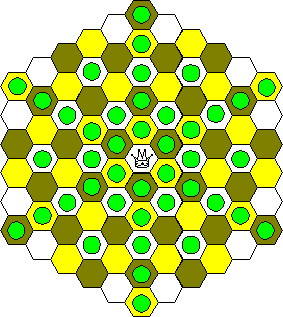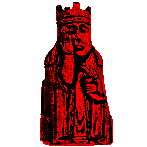Piececlopedia: Queen
Historical notes
In the end of the middle ages, the slow Ferz was replaced in the game of chess by the modern Queen. This was part of an overall reform of the rules of chess (c. 1475), making the game much faster. Although the Queen wasn't really based on the Ferz, its name was tied in with the history of its predecessor. In Chaturanga, the Ferz, which could move only one space diagonally, was called a mantri, meaning counsellor. The Persians translated the name as farzin, which had the same meaning. The Arabs shortened this name to firz, and this became ferz or fers in Europe. These became fercia, then fierge. According to Davidson, the sex of the piece changed through homophony between fierge and the French word vierge, which meant maiden or virgin. In a predominantly Catholic Europe, it was natural to make the association with the Virgin Mary, who was regarded as a lady and a queen. This led to calling the piece names that meant lady or queen. Most European languages began calling it a lady, but its place by the King's side made it natural to call it a queen. It is a lady in French (dame), German (Dame), and Italian (Donna). It is a Queen in English and various other languages. The Russian name is still ferz. The piece's name changed in this manner even before its powers changed. One legacy of this is the use of the name "dame" for checkers, which move one space diagonally. When its powers changed so drastically from the weak ferz to our modern Queen, it seemed all the more appropriate to retain the change in name.
Movement
The Queen is a compound piece that can move as a Rook or a Bishop. It moves an arbitrary number of spaces in any orthogonal or diagonal direction. It may not pass over occupied spaces, and it ends its move by occupying an empty space or by capturing an enemy piece. Orthogonal movement passes through rows of spaces that are connected to their neighbors in the row by shared sides. Diagonal movement passes through the corners of spaces, connecting spaces of the same color on a suitably checkered board.
Movement Diagrams
|
|

|
Notes
For more information on the orthodox chess queen, see our Illustrated rules of chess or the FIDE laws of chess.
In notation and ASCII diagrams, the Queen is represented by the letter Q.
Vocabulary: Compound
The Queen is a compound piece. This means that it combines the powers of two other pieces, being able to move as one or the other--though not as both at the same time. In the Queen's case, it combines the powers of the Rook and the Bishop. Each time the Queen moves, it moves either as a Rook or as a Bishop. The Queen is the only piece in regular Chess that is a compound of other pieces in the game. The King can be thought of as a compound of the Ferz and the Wazir, two pieces that are not found in standard Chess--though the King is no mere compound piece. Other commonly used compound pieces include the compound of Bishop & Knight and the compound of Rook & Knight.
Alternate Images
Click on an image to view the full piece set it belongs to.
 |
||
References
Davidson, Henry A. A Short History of Chess, 1949.
This is an item in the Piececlopedia: an overview of different (fairy) chess pieces.
Written by Fergus Duniho and Hans Bodlaender.
WWW page created: September 11, 1998.
